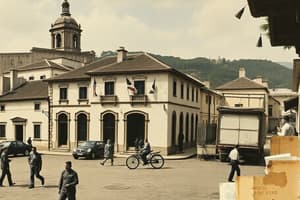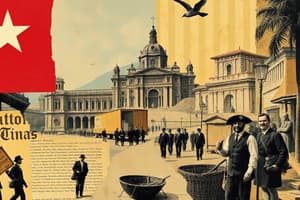Podcast
Questions and Answers
What act was established by Congress in 1900 to create a civil government for Puerto Rico?
What act was established by Congress in 1900 to create a civil government for Puerto Rico?
- The Jones Act
- The Foraker Act (correct)
- The Bell Act
- The Smith Act
By what year were Puerto Ricans allowed to elect their own governor?
By what year were Puerto Ricans allowed to elect their own governor?
- 1934
- 1900
- 1917 (correct)
- 1920
Who led the Filipino troops in their attack against American soldiers in 1899?
Who led the Filipino troops in their attack against American soldiers in 1899?
- José Rizal
- Manuel L. Quezon
- Andres Bonifacio
- Emilio Aguinaldo (correct)
What strategy did the U.S. military use to combat Filipino guerrillas during the rebellion?
What strategy did the U.S. military use to combat Filipino guerrillas during the rebellion?
Who was the first U.S. civilian governor of the Philippines?
Who was the first U.S. civilian governor of the Philippines?
What role did sugarcane plantations play in the conflict between the United States and Spain over Cuba?
What role did sugarcane plantations play in the conflict between the United States and Spain over Cuba?
What was a direct consequence of the economic ties between the United States and Cuba?
What was a direct consequence of the economic ties between the United States and Cuba?
How did José Martí contribute to the rebellion in Cuba?
How did José Martí contribute to the rebellion in Cuba?
What shift occurred in U.S. public opinion regarding the Cuban rebels?
What shift occurred in U.S. public opinion regarding the Cuban rebels?
What was the reaction of President Cleveland to the beginning of the uprising in Cuba?
What was the reaction of President Cleveland to the beginning of the uprising in Cuba?
What was a significant outcome of the Battle of Manila Bay?
What was a significant outcome of the Battle of Manila Bay?
Which American cavalry unit is prominently recognized for its role in Cuba during the war?
Which American cavalry unit is prominently recognized for its role in Cuba during the war?
What was a primary argument against the annexation of new territories?
What was a primary argument against the annexation of new territories?
What key battle did American forces engage in Cuba that contributed to the defeat of the Spanish troops?
What key battle did American forces engage in Cuba that contributed to the defeat of the Spanish troops?
Which territories were acquired by the United States following the Spanish-American War?
Which territories were acquired by the United States following the Spanish-American War?
What is yellow journalism primarily characterized by?
What is yellow journalism primarily characterized by?
What significant event occurred on February 15, 1898?
What significant event occurred on February 15, 1898?
Which of the following factors prompted American calls for intervention in Cuba?
Which of the following factors prompted American calls for intervention in Cuba?
What was the rallying cry for war against Spain?
What was the rallying cry for war against Spain?
What actions did Congress take in April 1898?
What actions did Congress take in April 1898?
Who led the American attack on the Spanish fleet in the Philippines?
Who led the American attack on the Spanish fleet in the Philippines?
What was a consequence of the Cuban Rebellion?
What was a consequence of the Cuban Rebellion?
What characterized the aggressive nationalism in the Republican Party during this period?
What characterized the aggressive nationalism in the Republican Party during this period?
What was a significant outcome of the Spanish-American War?
What was a significant outcome of the Spanish-American War?
Which argument was NOT part of the anti-imperialist movement's stance?
Which argument was NOT part of the anti-imperialist movement's stance?
What reason did President McKinley NOT cite for annexing the Philippines?
What reason did President McKinley NOT cite for annexing the Philippines?
What significant change occurred for the Philippines in 1946?
What significant change occurred for the Philippines in 1946?
What was one economic effect of the war on American investments?
What was one economic effect of the war on American investments?
Which provisions were included in the Platt Amendment?
Which provisions were included in the Platt Amendment?
What was a key financial outcome of the Treaty of Paris?
What was a key financial outcome of the Treaty of Paris?
How did the costs of the Spanish-American War and the Filipino guerrilla resistance financially impact the United States?
How did the costs of the Spanish-American War and the Filipino guerrilla resistance financially impact the United States?
After the Spanish-American War, the United States transformed primarily due to:
After the Spanish-American War, the United States transformed primarily due to:
What was a political consequence of the decision to annex the Philippines?
What was a political consequence of the decision to annex the Philippines?
Which of the following was a prominent figure opposing imperialism?
Which of the following was a prominent figure opposing imperialism?
Which reform helped reduce hostility among Filipinos after the war?
Which reform helped reduce hostility among Filipinos after the war?
How much did American investments grow from 1897 to 1904?
How much did American investments grow from 1897 to 1904?
What factor contributed to the call for the annexation of the Philippines?
What factor contributed to the call for the annexation of the Philippines?
What was one major effect of the U.S. annexation of the Philippines?
What was one major effect of the U.S. annexation of the Philippines?
What aspect of American military spending increased from $64 million in 1899 to $135 million in 1912?
What aspect of American military spending increased from $64 million in 1899 to $135 million in 1912?
Flashcards
Cuban Rebellion
Cuban Rebellion
A series of uprisings in Cuba against Spanish colonial rule, starting in 1868 and continuing in 1895, aiming for Cuban independence.
Sugarcane and Wealth
Sugarcane and Wealth
Sugarcane plantations in Cuba were a major source of wealth for Spain, generating a significant portion of the world's sugar production in the 1800s.
Spanish Atrocities
Spanish Atrocities
News reports about brutal treatment of Cubans by Spanish authorities, often exaggerated or fabricated, fueled public support for Cuban independence in the United States.
US-Cuba Economic Ties
US-Cuba Economic Ties
Signup and view all the flashcards
José Martí
José Martí
Signup and view all the flashcards
Spanish-American War
Spanish-American War
Signup and view all the flashcards
Battle of Manila Bay
Battle of Manila Bay
Signup and view all the flashcards
Rough Riders
Rough Riders
Signup and view all the flashcards
Annexation Debate
Annexation Debate
Signup and view all the flashcards
American Imperialism
American Imperialism
Signup and view all the flashcards
Yellow Journalism
Yellow Journalism
Signup and view all the flashcards
USS Maine Explosion
USS Maine Explosion
Signup and view all the flashcards
Jingoism
Jingoism
Signup and view all the flashcards
Dewey's Action
Dewey's Action
Signup and view all the flashcards
What impact did the USS Maine explosion have on US-Spain relations?
What impact did the USS Maine explosion have on US-Spain relations?
Signup and view all the flashcards
How did Yellow Journalism contribute to the Spanish-American War?
How did Yellow Journalism contribute to the Spanish-American War?
Signup and view all the flashcards
Why was the Spanish-American War fought on two fronts?
Why was the Spanish-American War fought on two fronts?
Signup and view all the flashcards
Foraker Act
Foraker Act
Signup and view all the flashcards
Puerto Rico's Status Debate
Puerto Rico's Status Debate
Signup and view all the flashcards
Emilio Aguinaldo
Emilio Aguinaldo
Signup and view all the flashcards
Concentration Camps in the Philippines
Concentration Camps in the Philippines
Signup and view all the flashcards
Taft's Strategy
Taft's Strategy
Signup and view all the flashcards
Anti-Imperialism Movement
Anti-Imperialism Movement
Signup and view all the flashcards
McKinley's Rationale for Annexation
McKinley's Rationale for Annexation
Signup and view all the flashcards
Treaty of Paris (1898)
Treaty of Paris (1898)
Signup and view all the flashcards
Platt Amendment
Platt Amendment
Signup and view all the flashcards
Rise of American Imperialism
Rise of American Imperialism
Signup and view all the flashcards
How did the Spanish-American War change the US?
How did the Spanish-American War change the US?
Signup and view all the flashcards
What were the major consequences of the Spanish-American War?
What were the major consequences of the Spanish-American War?
Signup and view all the flashcards
Filipino Resistance
Filipino Resistance
Signup and view all the flashcards
American Investment Boom
American Investment Boom
Signup and view all the flashcards
Military Spending Increase
Military Spending Increase
Signup and view all the flashcards
Economic Impact of War
Economic Impact of War
Signup and view all the flashcards
Filipino Autonomy
Filipino Autonomy
Signup and view all the flashcards
Philippine Independence
Philippine Independence
Signup and view all the flashcards
Cost of the War
Cost of the War
Signup and view all the flashcards





